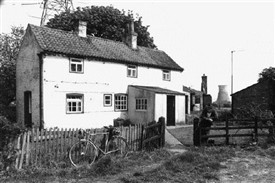John Wade - clockmaker of Staythorpe

John Wade's cottage in Staythorpe - now known as 'White Cottage'
Photographed in 1978 by Reg Baker
The location of White Cottage
"Making Time for John Wade"
By Jayne Amat
I can’t remember how or when I first heard about an eccentric 19th century clockmaker called John Wade living in Staythorpe, but I was sufficiently intrigued to try and find out more about him.
According to parish records, John Wade was born in 1776 in Shelton, Nottinghamshire, to William Wade and Elizabeth Bramhall. His siblings were Thomas (b.1774), Catherine (b.1779), William (b.1780) and Elizabeth (b.1783). John was Christened on 13 December 1776 at Shelton. He married Hannah Stepnall in South Collingham on 26 May 1835. Parish records indicate that they had a daughter, Mary Ann Wade, Christened 1 December 1803.
I don’t know when John and Hannah moved to Staythorpe but they were certainly living there in 1841, as both appear on the census of that year. John is described as a clockmaker aged 60, Hannah is also 60, and completing the household is Eliza Horspool, a servant aged 15. John and Hannah appear on the next Staythorpe census of 1851, where John is described as a clockmaker and land occupier of 13 acres. Also in the house on the night of the census was Sarah Dawson, an unmarried servant aged 16.
As the census doesn’t give an exact address for John, it was necessary to examine the 1841 tithe map for Staythorpe (held at Nottinghamshire Archives) in order to find out where he lived. He is described in the schedule (the written document which accompanies the map) as a tenant of 13 acres. His land and property are described as “Hough Close”, “Home Close”, “House, Garden and Orchard” and “Part of Cottage Meadow”. Most of John’s land (which he rented from Trinity College, Cambridge) surrounded his cottage apart from one narrow field adjacent to the River Trent, close to the boundary with Averham. His house is still standing and is now known as ‘White Cottage’.
John’s wife Hannah died in 1861 and he subsequently moved away from Staythorpe. The 1861 census records that he was living with his nephew, William Wade, at Syerston, Nottinghamshire. John’s occupation is given as ‘joiner’, not clockmaker, and one could speculate that if he was still working, his eyesight may have become too poor for him to continue close-up mechanical work and he may have turned his attention exclusively to cabinet-making.
John died at Syerston on the 30 August 1862, aged 86. His death notice in the Nottinghamshire Guardian newspaper on 12 Sept 1862 describes him as “formerly a cottage farmer at Staythorpe”. Sadly, there is no mention of his clock making activities. He was buried at the church of St Michael and All Angels in Averham on the 1st September 1862.
So what else do we know about John Wade? Luckily, I discovered a reference to him which gives us a tantalising glimpse as to what he was like as a person. The following extract is from the book ‘Memorials of Old Nottinghamshire’ edited by Everard L. Guilford and published by George Allen and Company in 1912:
“About 1840 a lamentable, though not unexpected, event happened. The cabinetmakers in Newark became tired of making cases for the clockmaker, and the practice began of the clockmaker making the movements for their cases, and though in itself a regrettable feature, the result has left us some really beautiful cases of this period……..In contradistinction to this procedure, we have to note R. Wade of Staythorpe, a village four miles from Newark, who combined the two operations. A clock-case maker by trade, he went to London to work in the piano-case trade and clock-case making, and there he conceived a fancy for the mechanical side of clock making. After some years he returned to Staythorpe, and set up as a maker of both clock and case. His work was of a very creditable character, and quite a number of his clocks are in good working order in the neighbourhood. He was an eccentric character, and left his mark in many little details about the premises which he occupied in Staythorpe until his death.”
Eagle-eyed readers will have noticed the in the extract he is referred to as R. Wade. I can find no evidence whatsoever of an R. Wade living in Staythorpe at the time so I am confident that this is an error.
What puzzles me is where the author found his information. Perhaps by word of mouth, from local inhabitants? I’m sure that most villagers would remember an eccentric clockmaker living in their midst and perhaps pass his story down to the next generation. Sadly the author doesn’t reveal his sources. In what way was Wade “eccentric” and what were the “marks” he left at his premises? We may never know.
Despite the best efforts of the extremely helpful and knowledgeable staff at the British Horological Institute in Upton, no further details about John Wade’s clock making career could be found. Sadly, the Institute doesn’t have any examples of his work but a member of staff did tell me that many clocks do not stray too far from their place of manufacture. If readers know of the existence of any John Wade clocks, or have any further information about John Wade, please do get in touch with me.
This article first appeared in February 2015 edition of 'The Plough' - the parish magazine for Averham, Kelham & Staythorpe http://aksplough.co.uk- to whom we are indebted for permission to reproduce it here.
If anyone has more information about John Wade, or even owns one of his clocks, please leave a 'Comment' via the link below. Thank you.